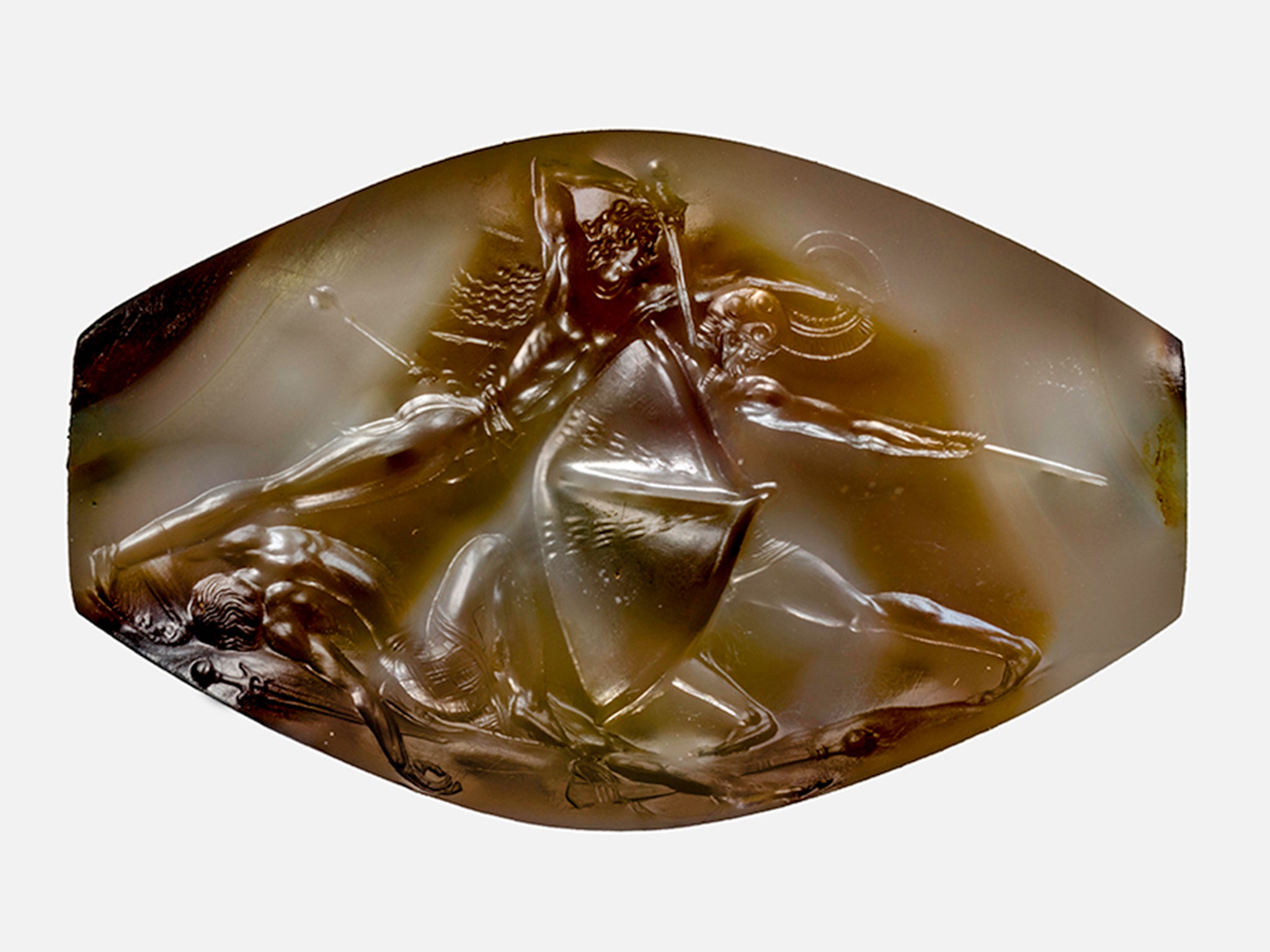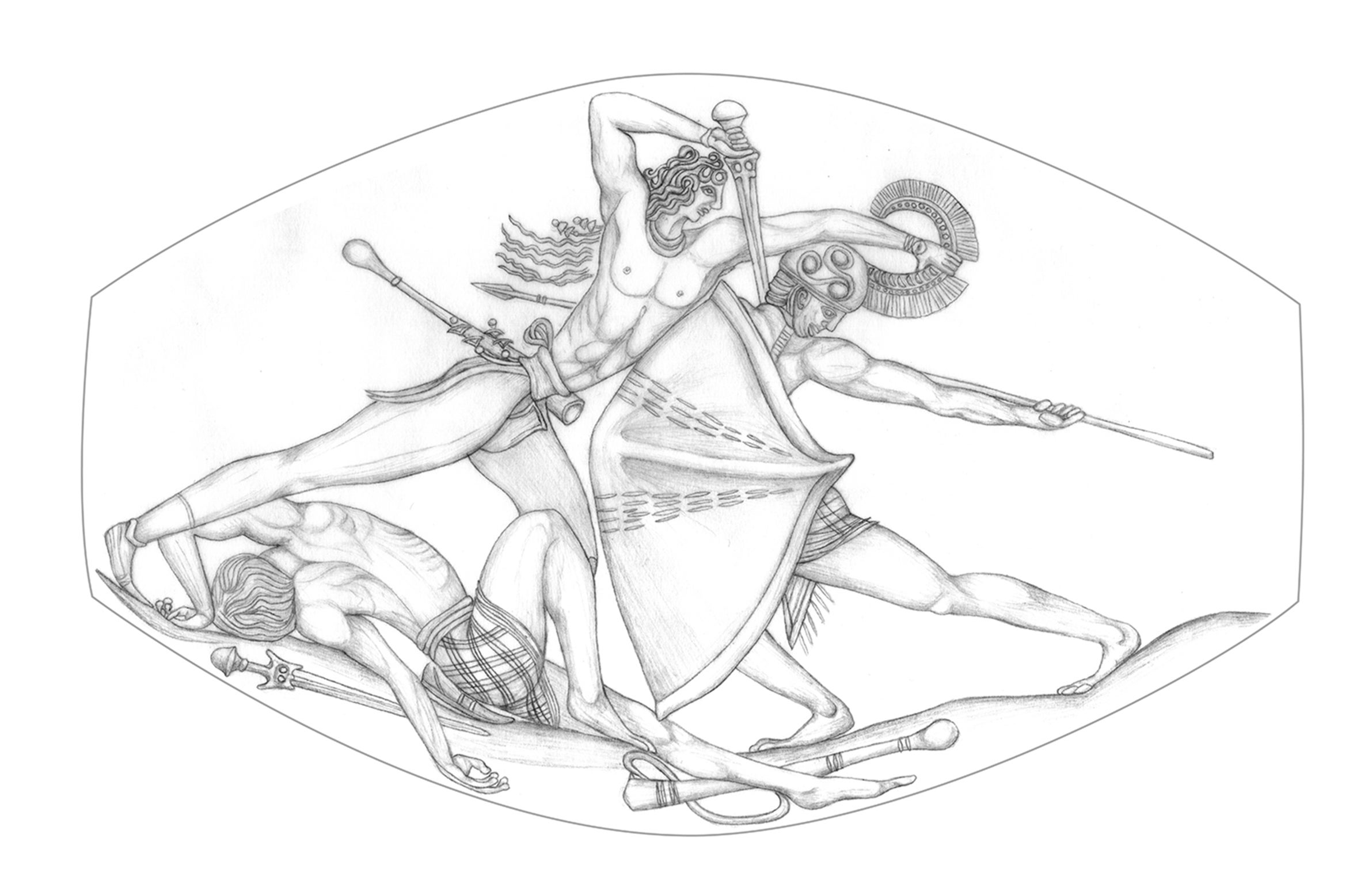How does a Grecian artifact appear to evoke tales from Homer's 'Iliad' and 'Odyssey'?
An engraved stone with a finely detailed battle scene was found in the grave of a warrior buried about 1450BC

Your support helps us to tell the story
From reproductive rights to climate change to Big Tech, The Independent is on the ground when the story is developing. Whether it's investigating the financials of Elon Musk's pro-Trump PAC or producing our latest documentary, 'The A Word', which shines a light on the American women fighting for reproductive rights, we know how important it is to parse out the facts from the messaging.
At such a critical moment in US history, we need reporters on the ground. Your donation allows us to keep sending journalists to speak to both sides of the story.
The Independent is trusted by Americans across the entire political spectrum. And unlike many other quality news outlets, we choose not to lock Americans out of our reporting and analysis with paywalls. We believe quality journalism should be available to everyone, paid for by those who can afford it.
Your support makes all the difference.Two years ago, archaeologists excavating an ancient grave at Pylos in south-western Greece pulled out a grime-encrusted object, less than 4cm long, that looked like some kind of large bead. They put it aside to focus on more prominent items, like gold rings, that also were packed into the rich grave.
But later, as a conservator removed the lime accretions on the bead’s face, it turned out to be something quite different: a seal stone, a gemstone engraved with a design that can be stamped on clay or wax.
The seal stone’s image, a striking depiction of one warrior in battle with two others, is carved in remarkably fine detail, with some features that are barely visible to the naked eye. The image is easier to appreciate in a large-scale drawing of the original.
“The detail is astonishing, especially given the size. Aesthetically, it’s a masterpiece of miniature art,” says John Bennet, director of the British School at Athens, an archaeological institute.
“The stunning combat scene on the seal stone, one of the greatest masterpieces of Aegean art, bears comparison with some of the drawings in the Michelangelo show now at the Metropolitan Museum of Art,” says Malcolm H Wiener, an expert on Aegean prehistory and a trustee emeritus of the Met.
The seal stone comes from an untouched shaft grave near the ancient palace of Pylos. The grave was discovered in May 2015 by Jack L Davis and Sharon R Stocker, archaeologists at the University of Cincinnati who had been digging at Pylos for more than 25 years.
“It was after cleaning, during the process of drawing and photography, that our excitement slowly rose as we gradually came to realise that we had unearthed a masterpiece,” they wrote in the journal Hesperia.
The seal stone presents two mysteries. One is how and why it was engraved in such detail. The other is whether its battle scene, strongly evocative of those in Homer’s Iliad and Odyssey, depicts an event that contributed to the oral tradition behind the works of Homer.
The seal stone’s owner, known as the Griffin Warrior after the mythical animal depicted in his grave, was buried around 1450BC. He lived at a critical period when the Minoan civilisation of Crete was being transferred to cities of the Greek mainland.
Local chieftains, as the Griffin Warrior may have been, used precious items from Crete to advertise their membership in the Greek-speaking elite of the incipient Mycenaean civilisation, the first on mainland Europe. Their descendants, a century or so later, built the great palaces at Pylos, Mycenae and Tiryns, places mentioned by Homer.
Davis and Stocker believe that the seal stone, like other objects in the Griffin Warrior’s grave, was made on Crete. Work of such quality was not being produced anywhere on the Greek mainland at the time. The detail is so fine that it seems the engraver would have needed a magnifying glass, as would admirers of his work.
Yet no magnifying implements have been found on Crete from this era. Perhaps the engraver was nearsighted, the two archaeologists suggest.
Fritz Blakolmer, an expert on Aegean art at the University of Vienna, argues that the seal stone is a miniature copy of a much larger original, probably a stucco-embellished wall painting like those found at the Palace of Knossos on Crete. He says the seal must have been engraved by someone with a magnifying glass, even though none has been found, and dismisses the possibility that people of that era had sharper eyesight than today.
The seal, carved on a hard stone known as agate, shows a victorious hero slaying an adversary while a third warrior lies dead in the foreground. The seal stone is mounted so that it can worn on the wrist, and indeed the hero is wearing just such an item, as if it were a wristwatch.
The two defeated warriors seem to belong to the same group, because both are wearing patterned kilts whereas the hero sports a codpiece. The scene evidently represents some event that would have been familiar to the Minoans who made the seal stone and to the Griffin Warrior’s community.

The seal stone’s possible relevance to the Homeric epics is intriguing but elusive. Early archaeologists, such as Heinrich Schliemann, who first excavated Troy and Mycenae, believed the Iliad recounted historical events and were quick to see proof of this in the artifacts they found.
Later archaeologists were more doubtful, but allowed that the destruction of Troy in 1200BC could have been remembered in oral poetry for 500 years until the Homeric poems were first written down, around 700BC.
The Griffin Warrior was buried around 1450BC, distancing him even further from the first written version of Homer. Still, there is some evidence that the oral tradition behind the Homeric epics traces as far back as Linear B, the earliest documented Greek writing system.
Linear B was adapted by the Mycenaean Greeks from Linear A, used by the Minoans. The oldest known Linear B inscriptions date to 1450BC, and the script disappeared after the collapse of Mycenaean civilisation around 1200BC.
Some of the scansion problems in the Homeric poems “can be resolved if you restore older forms of Greek which are consistent with the dialect recorded in Linear B documents”, says Bennet of the British School at Athens.
So the oral tradition that led to the Homeric epics perhaps stretched over seven centuries.
“We’re not saying this is a representation from Homer,” Stocker says of the tableau on the seal stone, while admitting it would be “fun to believe” the hero is Achilles. Rather, the image “is part of a cycle of stories familiar to both Mycenaeans and Minoans”.
Blakolmer, too, finds it tempting to see the figures on the seal as Homeric heroes, like Hector or Nestor, but in his view the temptation must be resisted.
“Fifty years ago, you would find nice attributions to Homeric heroes, but today’s academics are very careful in their Homeric attributions,” he says. “We have to make our own mistakes, not theirs.”
© New York Times
Join our commenting forum
Join thought-provoking conversations, follow other Independent readers and see their replies
Comments